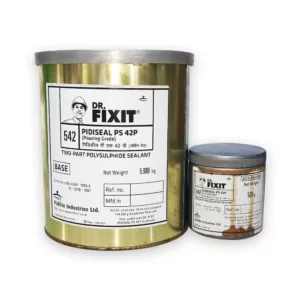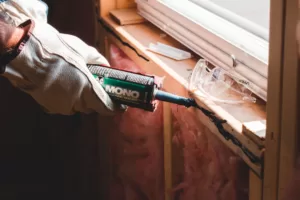1.Polysulphide Sealant (PS Sealant)
Description:
Polysulfide sealant (PS sealant) is a type of elastomeric sealant that is known for its excellent flexibility and durability. It is made from a polymer resin that is derived from the reaction of a polysulfide polymer and a curative agent. The resulting material is a two-component system that typically includes a base component and a curing agent.
PS sealant is often used in construction and industrial applications to seal joints and gaps in a variety of substrates, including concrete, metal, wood, and glass. It is particularly well-suited for applications where movement and vibration are expected, as it has the ability to accommodate a certain degree of joint movement without cracking or breaking.
PS sealant is also resistant to a variety of environmental conditions, including weathering, aging, and chemicals. It can be formulated to provide specific levels of adhesion, cure time, and other properties, depending on the specific application requirements.
PS sealant is available in two main types: pour grade and gun grade. Pour grade PS sealant is a thixotropic material that has a high viscosity and is designed to be poured into joints or cavities. Gun grade PS sealant, on the other hand, is a lower viscosity material that is designed to be dispensed using a caulking gun or other similar application equipment.


Polyurethane sealant (PU sealant) is a type of elastomeric sealant that offers several advantages over other types of sealants:
- Excellent adhesion: PU sealant has excellent adhesion to a variety of substrates, including concrete, metal, wood, and plastic. It creates a strong bond that can withstand a certain degree of joint movement without cracking or breaking.
- High elasticity: PU sealant has a high degree of elasticity, which allows it to accommodate joint movement without losing its sealing properties. This makes it an ideal choice for sealing joints in buildings and other structures where movement is expected.
- Weather resistance: PU sealant is highly resistant to weathering, aging, and UV radiation. This means it can maintain its sealing properties over a long period of time, even in harsh environmental conditions.
- Chemical resistance: PU sealant is resistant to a wide range of chemicals, including acids, alkalis, and solvents. This makes it suitable for use in chemical plants, refineries, and other industrial applications.
- Versatility: PU sealant is available in a range of formulations that can be tailored to specific applications. It can be used for sealing joints, filling gaps, and bonding substrates together.
- Paintable: Some variants of PU sealant can be painted over once it has cured, making it a good choice for applications where the sealant needs to blend in with the surrounding material. However, it is important to note that not all types of PU sealant are suitable for painting, so it is important to check the manufacturer’s instructions before attempting to paint over the sealant.
While polyurethane sealant (PU sealant) has many advantages over other types of sealants, there are also some potential disadvantages to consider:
- Higher cost: PU sealant is typically more expensive than other types of sealants, which can be a consideration for projects with tight budgets.
- Longer curing time: PU sealant can take longer to cure than other types of sealants, which can slow down project timelines.
- Strong odor: PU sealant can emit a strong odor during application and curing, which can be unpleasant and require additional ventilation.
- Limited color options: PU sealant is generally only available in a limited range of colors, which can be a disadvantage for projects that require a specific color match.
- More difficult to apply: PU sealant can be more difficult to apply than other types of sealants, as it requires careful mixing and application to ensure proper adhesion and curing.
- May require special tools: Some types of PU sealant may require special tools or equipment for application, which can add to project costs.


Polyurethane sealant (PU sealant) is a versatile sealing material that can be used for a wide range of applications. Some common uses for PU sealant include:
- Sealing joints: PU sealant can be used to seal joints in buildings and other structures, such as expansion joints, control joints, and window and door frames.
- Filling gaps: PU sealant can be used to fill gaps and cracks in walls, floors, and other surfaces.
- Bonding substrates: PU sealant can be used to bond substrates together, such as metal to concrete or wood to plastic.
- Waterproofing: PU sealant is an effective material for waterproofing applications, such as sealing roofs, decks, and foundations.
- Automotive applications: PU sealant is commonly used in automotive applications, such as sealing windshields and other glass components, and for general body panel bonding.
- Industrial applications: PU sealant is used in a range of industrial applications, including sealing joints and bonding substrates in construction, marine, and aerospace industries.
- Electrical applications: PU sealant can be used for electrical insulation and sealing applications, such as sealing cable and wire entries.
The specific application instructions for Polyurethane sealant (PU sealant) can vary depending on the specific product and the application, in general, the following steps can be followed:
- Surface preparation: The surface to be sealed should be clean, dry, and free of any dirt, dust, oil, or other contaminants. If necessary, the surface can be cleaned with a solvent or other cleaner.
- Joint design: The joint or gap to be sealed should be designed to accommodate the expected movement of the substrate. The joint should be sized and shaped according to the manufacturer’s recommendations.
- Primer application: Some PU sealants require the use of a primer to ensure proper adhesion. If a primer is required, it should be applied according to the manufacturer’s instructions and allowed to dry before applying the sealant.
- Sealant application: The PU sealant can be applied using a caulking gun or other suitable applicator. The sealant should be applied in a continuous bead, ensuring full contact with both sides of the joint. The sealant should be tooled or smoothed immediately after application to ensure proper adhesion and finish.
- Curing time: The PU sealant will require a certain amount of time to cure, which can vary depending on the specific product and environmental conditions. The manufacturer’s instructions should be followed to determine the appropriate curing time.
- Cleanup: Any excess sealant should be cleaned up immediately using a solvent or other suitable cleaner. Once cured, the sealant may require mechanical removal.
It is important to read and follow the manufacturer’s instructions for the specific product being used, as different products may have different application instructions and cure times. Additionally, proper ventilation should be used during application to minimize exposure to any fumes or odors.
GEOLIZ WATERPROOFERS PVT. LTD.
Waterproofing Products & Services Guide
For details on other waterproofing products & Services
